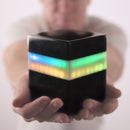Introduction: Giant Reclaimed Timber LED Floor Lamp W/ Music Reactive LEDs
This Instructable explains the steps to make a modern industrial LED floor lamp from a reclaimed timber beam and steel. I made this lamp to match the modern industrial style of brick and timber loft. I’m pretty pumped how it came out – hopefully you all enjoy it too! I built this lamp with my friend Jonny Lambert (from the Jonny Builds YouTube channel), so that is who I’m referring to when I say “we.”
The lamp is made from a 60 year-old reclaimed douglas fir beam and 1/4" steel. A 480-LED matrix is embedded in the beam, and includes a controller that can switch between solid light in various shades of white, and a reactive mode where the LED matrix reacts to music or other sounds in the environment (like my voice). The reactive mode is best experienced by watching the video I made documenting the build process
Materials:
6 ft. Reclaimed Beam – just Google search for reclaimed wood in your area, and you’ll likely find a source 1/4"
Steel Plate, 20 ft length of 8” wide -- again, do a Google search for a steel yard in your area
4x4 lumber (one 8' board)
1/4" locking nuts
1/4" threaded rod
SK6812 WWA LED Strips: https://amzn.to/2Jrp2Tu
LED Music Controller: https://goo.gl/mC8B5j
5V LED power supply: https://goo.gl/mC8B5j
White Acrylic sheet (for diffusers): https://goo.gl/mC8B5j
Shaper Origin: https://goo.gl/mC8B5j
Step 1: Routing the LED Cavity in the Beam
We used a Shaper Origin, combined with a traditional router, to create a cut-out for LED strips in the beam, and to cut matching white acrylic to serve as a diffuser for the LEDs. However, you could easily use an edge guide with a traditional router, or even a foerstner bit on a drill and a chisel, to carve out the cavity in the beam for the LEDs.
The Shaper Origin can be thought of as a handheld CNC (although it is more of a computer-vision assisted router). I decided to use it instead of a router, in order to create a precisely-shaped cavity for LEDs for in the old warped and cracked timber beam. The Origin was a particularly good tool for this task, since maneuvering the beam onto a traditional CNC would have proved difficult, and with the Origin, I could bring the CNC to the beam instead. Also, I could use the same cut file to create a matching acrylic diffuser that could be pressure fit into the cavity in the beam.
The cavity was 30” x 5” to accept a 6x80 array of SK6812 WWA individually controllable LEDs (made from 96 LED/m strips). After cutting the outer perimeter to 1/8” deep with the Origin, I used a standard router with a bottom cleaning bit to cut out a rectangle inset about 1/8” from the outer perimeter, leaving a rabbet for the 1/8” thick white acrylic diffuser.
I also used the Origin to cut the acrylic diffuser. By using the same file as I used to cut the cavity in the beam, but switching to an outside cut and offsetting it by 1/100th of an inch, I was able to cut an acrylic panel that pressure fit in the beam. (Very useful if the LEDs ever need to be changed out.)
Step 2: Cutting and Attaching the Steel Legs
We bought a 20 ft x 10” sheet of ¼” steel at the local steel yard. However, we could have saved a lot of work (and some money) by buying an 8” wide sheet, to match the width of the 8” beam. We ended up having to cut all our legs down to 8” wide because we bought the wrong width.
The first step is to cut the back legs. See the attached sketch for the angles and general shapes of the legs. We used a 30 degree lean for the lamp (or 60 degrees to the floor), so made a 30-degree cut at one end of each back leg, and a straight cut at the other end. The length will depend on the size of your beam. The easiest way to figure it out is to just hold the back legs up to the beam, and mark where they look right to your eye, and use a marker (dry erase or sharpie) to mark where the back legs overlap with the beam.
Then take the steel back legs to the drill press (or use a hand drill with a center punch to mark the spots to drill). Drill four holes in a square pattern in the area you marked where the back legs overlap with the beam. Then clamp the back legs to the beam, pre-drill matching holes in the beam, and attach the back legs to the beam using ¼” lag screws.
Now on to the front legs. First cut a 20 degree cut at the lower end (or 70 degrees to the floor) of each leg. This angle is sharper than the back legs, so the lamp will extend past the edge of the front legs and cast light over the area next to it. Now take the partially cut front legs over to the beam, and clamp them in place so you can mark the cut for the top of each front leg. Again, length will vary by beam size, so you really just have to hold the legs up and see where it looks right to your eye to cut. This is definitely a two person job (or even a three person job, depending on the people involved). Cut the legs where you marked them, and then drill four holes in the steel legs to attach them to the lamp. Also drill three holes at the lower end of each front leg, parallel to the floor, which will be used to attach the feet.
To make the feet we used scrap 4x4 lumber we found in the steel yards trash pile. I cut six (6) 8” lengths, and used wood glue to make two legs from these (3 8” lengths in each leg). We then used lag screws to attach the 4x4 feet in between the steel sheets for the front and back legs.
Lastly, for lateral stability, we drilled holes for two ¼” threaded rods in the middle of the front leg (spanning between the two steel sheets). We cut the threaded rods to size using an angle grinder and attached them with ¼” locking nuts.
Step 3: Wiring LEDs
To prep the beam for LEDs, I used an 18” long 3/8” auger bit to drill a hole from the LED cavity to the back of the lamp, so wires could be run through it.
I used SK6812 WWA individually controllable LEDs combined with an affordable off-the-shelf SP016E LED controller that has music reactive modes, chasing modes, and solid color modes, with an RF remote. (Note: these are similar to WS2811 and WS2812 LED strips, which could also be used if you want RGB LEDs.) Since I designed this for my own loft, the music reactive / sound reactive modes couldn’t be all that this lamp can do. It had to function and look like a normal lamp as well. With this in mind, I used the SK6812 warm white / cool white / amber LED strips, instead of RGB LED strips. In solid color mode, the LEDs can be adjusted via remote to give off various shades of white for a sophisticated modern look that hides the wild side when you switch the light to music visualizer mode.
I cut six lengths of LED strips (about 80 LEDs each), and soldered them in a snake formation to create a 6x80 LED matrix in the lamp. I soldered a couple feet of extension wire to the power, ground, and control wires, and ran them through the hole I cut with the auger bit to the back of the lamp, where I connected them to the SP106E controller.
Step 4: Fire Up the Lamp!
Now time to turn it on and enjoy!
I thought this design ended up being an interesting mix of old and new. It is industrial, and yet futuristic (especially when the lights react to your voice). It casts a nice light in the room when operated normally, and can also unleash its hidden party side, or even freak out unsuspecting friends when the lamp that appears to be off, starts reacting to their voice.

Participated in the
Creative Misuse Contest













